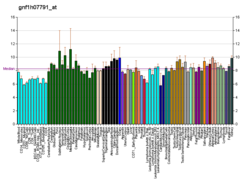CD109 (Cluster of Differentiation 109) is a human gene.[5]
CD109 is a GPI-linked cell surface antigen expressed by CD34+ acute myeloid leukemia cell lines, T-cell lines, activated T lymphoblasts, endothelial cells, and activated platelets (Lin et al., 2002). In addition, the platelet-specific Gov antigen system (HPA15),[6] implicated in refractoriness to platelet transfusion, neonatal alloimmune thrombocytopenia, and posttransfusion purpura, is carried by CD109 (Kelton et al., 1990; Lin et al., 2002).[supplied by OMIM][5]
See also
editReferences
edit- ^ a b c GRCh38: Ensembl release 89: ENSG00000156535 – Ensembl, May 2017
- ^ a b c GRCm38: Ensembl release 89: ENSMUSG00000046186 – Ensembl, May 2017
- ^ "Human PubMed Reference:". National Center for Biotechnology Information, U.S. National Library of Medicine.
- ^ "Mouse PubMed Reference:". National Center for Biotechnology Information, U.S. National Library of Medicine.
- ^ a b "Entrez Gene: CD109 CD109 molecule".
- ^ "IPD - HPA Sequence Database| EBI".
Further reading
edit- Lucas GF, Metcalfe P (2000). "Platelet and granulocyte glycoprotein polymorphisms". Transfusion Medicine (Oxford, England). 10 (3): 157–74. doi:10.1046/j.1365-3148.2000.00250.x. PMID 10972910. S2CID 43709043.
- Sutherland DR, Yeo E, Ryan A, et al. (1991). "Identification of a cell-surface antigen associated with activated T lymphoblasts and activated platelets". Blood. 77 (1): 84–93. doi:10.1182/blood.V77.1.84.84. PMID 1984805.
- Kelton JG, Smith JW, Horsewood P, et al. (1990). "Gova/b alloantigen system on human platelets". Blood. 75 (11): 2172–6. doi:10.1182/blood.V75.11.2172.2172. PMID 2346781.
- Lin M, Sutherland DR, Horsfall W, et al. (2002). "Cell surface antigen CD109 is a novel member of the alpha(2) macroglobulin/C3, C4, C5 family of thioester-containing proteins". Blood. 99 (5): 1683–91. doi:10.1182/blood.V99.5.1683. PMID 11861284.
- Schuh AC, Watkins NA, Nguyen Q, et al. (2002). "A tyrosine703serine polymorphism of CD109 defines the Gov platelet alloantigens". Blood. 99 (5): 1692–8. doi:10.1182/blood.V99.5.1692. PMID 11861285.
- Giesert C, Marxer A, Sutherland DR, et al. (2003). "Antibody W7C5 defines a CD109 epitope expressed on CD34+ and CD34- hematopoietic and mesenchymal stem cell subsets". Ann. N. Y. Acad. Sci. 996 (1): 227–30. Bibcode:2003NYASA.996..227G. doi:10.1111/j.1749-6632.2003.tb03250.x. PMID 12799300. S2CID 24117857.
- Mungall AJ, Palmer SA, Sims SK, et al. (2003). "The DNA sequence and analysis of human chromosome 6". Nature. 425 (6960): 805–11. Bibcode:2003Natur.425..805M. doi:10.1038/nature02055. PMID 14574404.
- Ota T, Suzuki Y, Nishikawa T, et al. (2004). "Complete sequencing and characterization of 21,243 full-length human cDNAs". Nat. Genet. 36 (1): 40–5. doi:10.1038/ng1285. PMID 14702039.
- Solomon KR, Sharma P, Chan M, et al. (2004). "CD109 represents a novel branch of the alpha2-macroglobulin/complement gene family". Gene. 327 (2): 171–83. doi:10.1016/j.gene.2003.11.025. PMID 14980714.
- Zhang JM, Hashimoto M, Kawai K, et al. (2005). "CD109 expression in squamous cell carcinoma of the uterine cervix". Pathol. Int. 55 (4): 165–9. doi:10.1111/j.1440-1827.2005.01807.x. PMID 15826242. S2CID 24693926.
- Lewandrowski U, Moebius J, Walter U, Sickmann A (2006). "Elucidation of N-glycosylation sites on human platelet proteins: a glycoproteomic approach". Mol. Cell. Proteomics. 5 (2): 226–33. doi:10.1074/mcp.M500324-MCP200. PMID 16263699.
- Liu T, Qian WJ, Gritsenko MA, et al. (2006). "Human Plasma N-Glycoproteome Analysis by Immunoaffinity Subtraction, Hydrazide Chemistry, and Mass Spectrometry". J. Proteome Res. 4 (6): 2070–80. doi:10.1021/pr0502065. PMC 1850943. PMID 16335952.
- Finnson KW, Tam BY, Liu K, et al. (2006). "Identification of CD109 as part of the TGF-beta receptor system in human keratinocytes". FASEB J. 20 (9): 1525–7. doi:10.1096/fj.05-5229fje. PMID 16754747. S2CID 30768709.
- Sjöblom T, Jones S, Wood LD, et al. (2006). "The consensus coding sequences of human breast and colorectal cancers". Science. 314 (5797): 268–74. Bibcode:2006Sci...314..268S. doi:10.1126/science.1133427. PMID 16959974. S2CID 10805017.
- Hasegawa M, Hagiwara S, Sato T, et al. (2007). "CD109, a new marker for myoepithelial cells of mammary, salivary, and lacrimal glands and prostate basal cells". Pathol. Int. 57 (5): 245–50. doi:10.1111/j.1440-1827.2007.02097.x. PMID 17493171. S2CID 23930267.
External links
edit- CD109+Antigen at the U.S. National Library of Medicine Medical Subject Headings (MeSH)
- Human CD109 genome location and CD109 gene details page in the UCSC Genome Browser.






